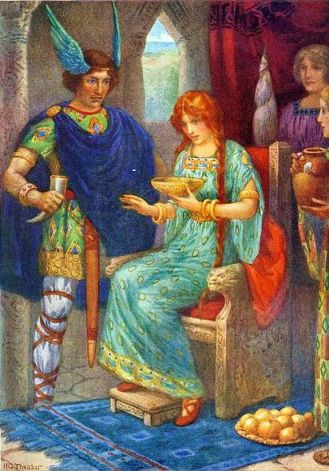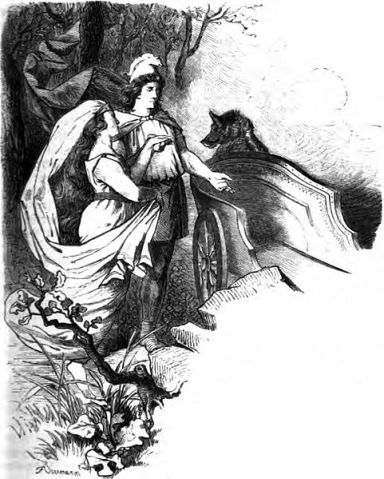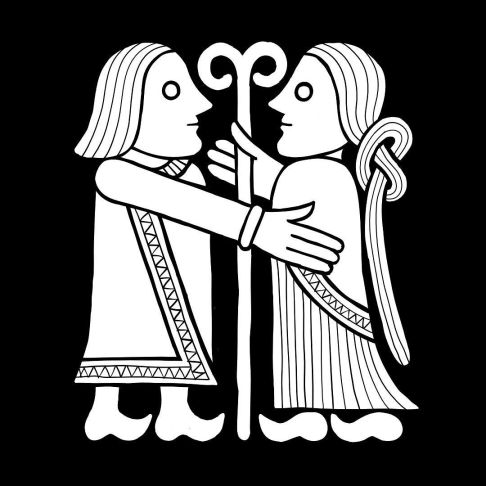Gerdr is the captivating goddess of both fertility and abundance and a beautiful Jötun. She is the wife of Freyr, one of the most important gods of the Vanir. She is the daughter of the jotnar Gymir and Aurboda. Gerdr’s character is an enigmatic one, embodying the mystery of nature, fertility, and growth. Her story also shows how common unions between the gods and the jotnar actually were.
Her marriage to Freyr moreover, symbolizes the harmony of the natural world and the nurturing power of the earth. I think that the tale of how Freyr sent his servant to court, or threaten her, as told in the Skírnismál, is also pretty entertaining.
Short Facts
Tribe: Jötun giantess by birth, Vanir, by marriage
Goddess of: fertility and abundance
Daughter of: The jotnar Gymir and Aurboda
Wife of: Freyr
Mother to: Fjölnir
Old Norse name: Gerðr
Meaning of name: Gerdr means enclosure or a fenced-in space in Old Norse
Other names: Gerd, Gerdhr
Origins and Family

Gerdr is a Jötun, or giantess, and the daughter of the jotnar Gymir and Aurboda. She gets married to Freyr, one of the most important Vanir gods after a brief but rather spectacular process of threats and charm. Despite coming from the Jötun race, Gerdr is not considered a threat to the gods. Instead, she seems to be viewed as a full goddess after her marriage. As such, their union across the divide of the gods and Jötun races is one of many.
With Freyr, Gerdr has a son named Fjölnir, Old Norse Fjǫlnir. He is said to later become a king in what is today Sweden, as the first of the Ynglings. His story, and him being succeeded by his son Svigdir is found in the Ynglingatal.
Gerdr’s responsibilities and powers
As a goddess of fertility and abundance, Gerdr is responsible for both the nurturing and growth of crops and plants, and life itself. She is believed to have powers to ensure bountiful harvests, representing the fertile soil and the earth’s natural abundance.
Her role encompasses the promotion of growth and prosperity for both the gods and humans. This connection with the natural world is also very much in tune with the Vanir as a nature-tribe of gods.
She is known for her beauty, which reflects the splendor of the natural world and captures the essence of nature’s nurturing power. She was surely beautiful as, after all, Freyr fell in love with her at first sight.
Gerdr and Freyr’s Union – Love at First Sight
The love story of Gerdr and Freyr begins with a moment of breathtaking beauty. Freyr, sitting on Odin’s high seat, Hlidskjalf, gazes upon the world. Deep in Jotunheimr, he catches sight of the beautiful Gerdr in her father’s garden. He falls in love with her instantly and is consumed with a desire to make her his wife.
To win Gerdr’s hand, Freyr sends his servant, Skirnir, as an emissary to negotiate the union. Skirnir approaches this by first trying to impress her with gifts and promises on Freyr’s behalf. Gerdr is not at all interested in a union with Freyr, moreover she turns Skirnir down completely. Skirnir is however not easily dissuaded. Soon he turns to vile threats amounting to a life in never ending torment should she not come around.

In the Poetic Edda, the poem “Skírnismál” details the whole story of Freyr and Gerdr. Stanza 40 describes the moment when Gerdr finally agrees to marry Freyr:
“There is a forest, Barri, that we both know well,
A fair and peaceful place;
And in nine nights from now, to Njord’s son,
Gerd will grant pleasure there.”
(Skírnismál, translated by Henry Adams Bellows)
Their union symbolizes the marriage of the sky and the earth, with Freyr representing the sun and warmth, and Gerdr embodying the fertile earth. Their love story exemplifies the harmony between the Vanir gods and the Jotuns and the balance of nature.
In an age of #metoo and a less patriarchal society, I think Freyr’s courtship might be viewed in less favorable terms however.
Gerdr’s Role in Norse Mythology
Her role as a fertility and abundance goddess is deeply rooted in the earth and its natural cycles. Her connection to the land makes her an essential figure in Norse cosmology, as she represents the earth’s inherent ability to provide nourishment and support life.
With Gerdr’s responsibilities and marriage with Freyr, she is very close to Freyr’s twin sister Freyja. She is also known for her beauty, close association with nature and fertility. This seeming overlap of areas of responsibility is quite normal and also found among the Greek gods and goddesses for example.
In addition to her responsibilities for the growth of crops and plants, Gerdr’s powers also extend to the fertility of animals and humans. As such, she was often invoked by those seeking bountiful harvests, successful pregnancies, and thriving offspring. Gerdr’s relationship with Freyr, the god of fertility and prosperity, further emphasizes their combined role in ensuring the flourishing of life on earth.
Her role in Norse mythology also highlights the interconnectedness of all living things and the cyclical nature of life, death, and rebirth. Gerdr’s nurturing spirit serves as a constant reminder of the delicate balance that sustains life and the importance of honoring the earth and its abundant gifts.
Play Fun Norse Quiz
Is this article making you even more curious about Norse gods and goddesses? You can satisfy your curiosity by playing a fun Norse mythology quiz. This way, you can test your knowledge about Norse gods and goddesses, as well as fill in some gaps. Good luck and have fun playing!
Don’t forget to try our other games as well!
Gerdr in Old Texts and Other Sources

Gerdr is mentioned in several Old Norse texts and sources, including both the Poetic Edda and the Prose Edda. In the Poetic Edda, the poem “Skírnismál” tells the story of Gerdr and Freyr’s unconventional courtship and eventual union.
In the Prose Edda, Gerdr is mentioned in the Gylfaginning as the wife of Freyr and a central figure in the mythological narrative. Her role as a goddess of fertility and abundance is further explored in various skaldic poems and kennings, where she is often associated with the earth, life, and prosperity.
As a captivating figure in Norse mythology, Gerdr’s story continues to inspire those who delve into the rich tapestry of Norse beliefs and traditions. Her tale of love and the harmony she represents between the natural world and the divine serves as a powerful reminder of the beauty, mystery, and nurturing power of the earth.
FAQs
Gerdr is a beautiful giantess from Jotunheim, the realm of giants, in Norse mythology. She is the daughter of the giant Gymir and the giantess Aurboda, and becomes the wife of the fertility god Freyr.
Freyr fell in love with Gerdr after he saw her when sitting in Odin’s high seat Hlidskjalf. He then sent his servant Skirnir to woo her on his behalf. Skirnir successfully convinced Gerdr to marry Freyr after first offering her gifts, but finally resorting to vile threats.
Their marriage symbolizes the union between the Vanir (fertility gods) and the Jotnar (giants), highlighting the importance of balance and harmony in nature. It also represents the merging of opposing forces in the Norse cosmos.
Gerdr is associated with the earth and its fertility. As Freyr’s wife, she is linked to the bountifulness of the land and agricultural prosperity.
Gerdr and Freyr’s story is told in the Skirnismal, found in the Poetic Edda. It recounts the story of how Freyr’s servant Skirnir won her hand in marriage for Freyr. This myth showcases the lengths the gods would go to secure love and alliances.
Gerdr is often depicted as a stunningly beautiful giantess, surrounded by elements of nature and fertility. In literature however, she is usually portrayed as a reserved and elusive character who is won over by Freyr’s persistence and Skirnir’s determination.
Featured Image Credit: Lorenz Frølich, Public domain, via Wikimedia Commons
